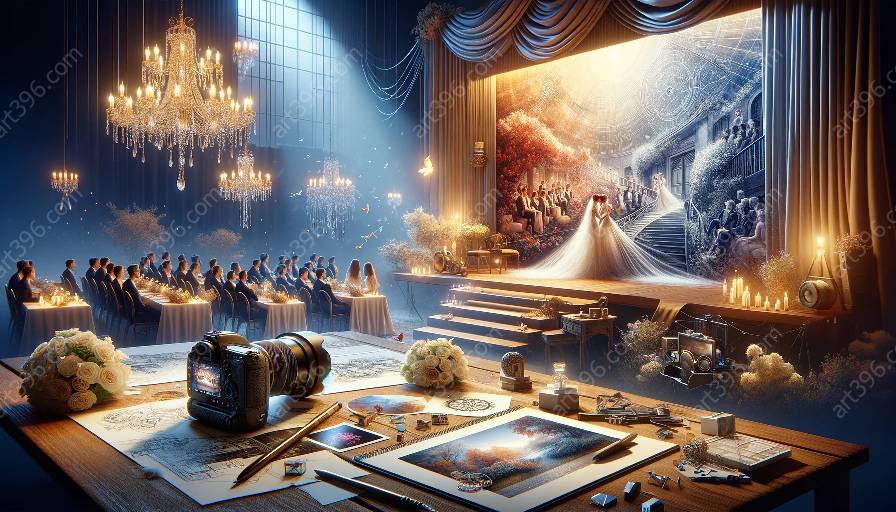Wedding photography is a specialized form of art that requires a deep understanding of photography techniques and equipment. The choice of lens plays a significant role in capturing the essence of this special occasion. In this topic cluster, we will explore the impact of lens choice on wedding photography and its relevance to the wider field of photographic and digital arts.
Understanding Lens Choices
Before delving into the impact of lens choice on wedding photography, it is important to understand the variety of lenses available to photographers. Different lenses offer unique perspectives, focal lengths, and apertures, each affecting the final outcome of an image.
Key Factors to Consider
When selecting a lens for wedding photography, several key factors come into play. These include:
- Focal Length: The focal length of a lens determines the angle of view and magnification. Wide-angle lenses capture a broad scene, while telephoto lenses bring distant subjects closer.
- Aperture: The aperture controls the amount of light that enters the lens. A wider aperture (lower f-stop) allows for a shallower depth of field, ideal for capturing intimate moments, while a narrow aperture (higher f-stop) provides greater depth of field for group shots or landscapes.
- Image Stabilization: Wedding environments are often varied and dynamic. Image stabilization can be crucial for capturing sharp, blur-free images, especially in low-light situations or when shooting handheld.
- Size and Weight: The practicality of a lens is also an important consideration for wedding photographers. Lightweight and compact lenses can enhance mobility and flexibility during the event.
The Impact on Storytelling
Wedding photography is about telling a story through images, capturing emotions, interactions, and the overall atmosphere of the day. The choice of lens greatly influences the storytelling aspect of wedding photography:
- Wide-Angle Lenses: These lenses excel at encompassing the entire scene, making them ideal for capturing the grandeur of a wedding venue, group portraits, or sweeping landscapes.
- Standard Lenses: A standard lens, such as a 50mm prime lens, offers a natural perspective similar to the human eye. It can capture genuine moments with minimal distortion, making it suitable for candid shots and intimate portraits.
- Telephoto Lenses: Telephoto lenses allow photographers to discreetly capture candid moments from a distance, without intruding on the subjects' privacy. They also excel at isolating individual subjects from the background, creating stunning portraits with pleasing background blur.
- Macro Lenses: These lenses are perfect for capturing intricate details, such as the wedding rings, floral arrangements, or any small decorative elements that contribute to the overall ambiance of the event.
Artistic Expression and Style
From a creative standpoint, the choice of lens can significantly impact a photographer's artistic expression and style. Each lens type imparts a distinct visual character to the images it produces, allowing photographers to craft a unique visual narrative:
- Bokeh and Background Compression: Lenses with wider apertures create beautiful bokeh, the out-of-focus area in an image, which adds a dreamy and romantic quality to wedding photos. They also provide pleasing background compression, isolating the subject and creating a sense of depth and separation from the surroundings.
- Perspective Distortion: Wide-angle and fisheye lenses can add a dynamic and creative touch to wedding photography by introducing perspective distortion and unusual angles, giving a fresh perspective to familiar scenes.
- Creative Close-Ups: Macro lenses excel at capturing stunning close-up details, allowing photographers to highlight the intricate beauty of wedding elements that might otherwise go unnoticed.
- Understand the Venue: Consider the size and layout of the wedding venue to determine the most suitable focal lengths and perspectives that can effectively capture the ambiance and details of the event.
- Consult with the Couple: Understand the couple's preferences and vision for their wedding photography. Some couples may prioritize candid moments, while others may want to emphasize the grandeur of the venue and the decor.
- Balance Versatility and Specialization: While a versatile zoom lens can cover a wide range of situations, specialized prime lenses can offer superior image quality and creative possibilities for specific types of shots.
- Test and Practice: Familiarize yourself with different lenses and their capabilities through practice and experimentation. Understanding how each lens performs in various lighting conditions and scenarios can be invaluable for making the right choices during a wedding shoot.
- Conclusion
Tips for Choosing the Right Lens
Selecting the best lens for wedding photography can be challenging. Here are a few tips to help photographers make informed decisions:
The choice of lens is a powerful tool that directly influences the visual storytelling of wedding photography. By carefully considering factors such as focal length, aperture, and image stabilization, photographers can select the most appropriate lenses to capture the emotions, details, and unique moments that make every wedding a truly unforgettable occasion.



















































